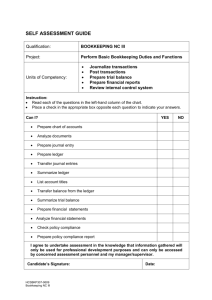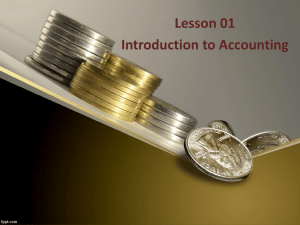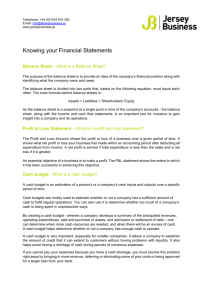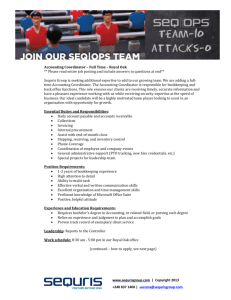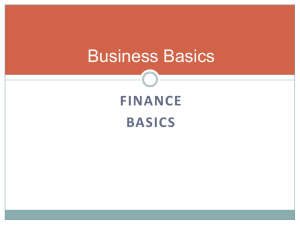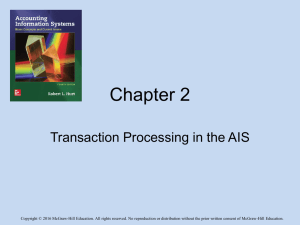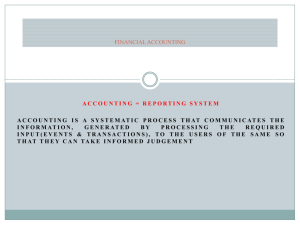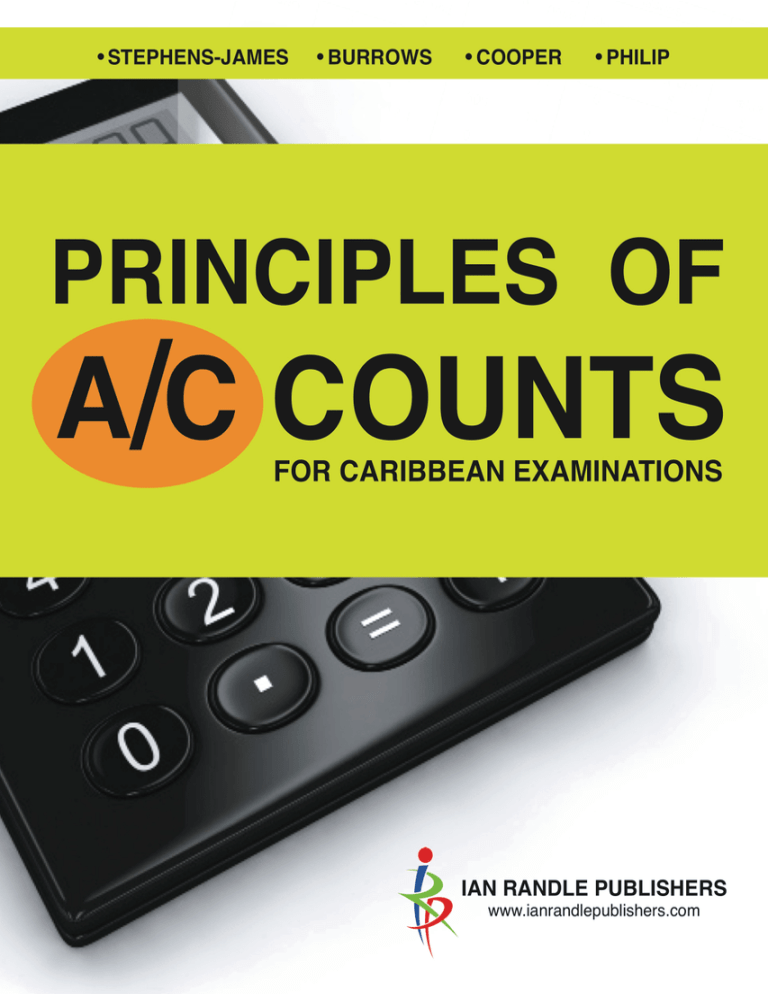
Basics in Accounting
Principles of Accounts
for Caribbean Examinations
19
22
Principles of Accounts
First published in Jamaica, 2011 by
Ian Randle Publishers
11 Cunningham Avenue
Box 686
Kingston 6
www.ianrandlepublishers.com
© 2011, Lystra Stephens-James, Nigel Cooper, Lesley Burrows, Kirk Philip
National Library of Jamaica Cataloguing-in-Publication Data
Principles of Accounts for Caribbean Examinations / Lystra Stephens-James … [et al]
p. ; cm.
ISBN 978-976-637-532-4 (pbk)
1
I
Accounts – Examinations, questions, etc.
Stephens-James, Lystra
657.076 dc 22
All rights reserved. No part of this publication may be reproduced, stored in a retrieval system, or
transmitted in any form, or by any means electronic, photocopying, recording or otherwise without
prior permission of the author or publisher.
Cover and book design by Ian Randle Publishers
Printed in United States of America
Basics in Accounting
1
CONTENTS
Preface .............................................................................................................................................. vii
The School Based Assessment ......................................................................................................... ix
1.
Basics in Accounting ..............................................................................................................1
2.
Basic Features and Records ............................................................................................... 12
3.
Accounting for a Business ................................................................................................... 19
4.
Introduction to the Ledger Accounts .................................................................................... 29
5.
Books of Original Entry ........................................................................................................ 54
6.
Day Books, Ledgers and the Trial Balance .......................................................................... 90
7.
Preparation of Unadjusted Financial Statements for a Sole Trader .................................... 112
8.
End of Year Adjustments ....................................................................................................130
9.
Inventory (Stock) Valuation ................................................................................................ 149
10.
Introduction to Ratio Analysis ............................................................................................ 161
11.
Control Systems: Errors and Suspense Accounts ............................................................. 175
12.
Control Systems: Control Accounts .................................................................................. 183
13.
Incomplete Records ........................................................................................................... 196
14.
Bank Reconciliation Statements ........................................................................................ 212
15.
Partnership Accounting ..................................................................................................... 224
16.
Accounting for Corporations .............................................................................................. 243
17.
Accounting for Co-operative Societies ............................................................................... 254
18.
Accounting for Non-Profit Organisations ........................................................................... 272
19.
Manufacturing Accounts .....................................................................................................290
20.
Payroll Accounting ............................................................................................................. 305
vi
Principles of Accounts
Glossary of Terms ........................................................................................................................... 318
Glossary Activity ............................................................................................................................. 331
Basics in Accounting
19
PREFACE
This text is primarily produced for students preparing for the Caribbean Examinations Council’s (CXC)
Caribbean Secondary Education Certificate (CSEC) Principles of Accounts examination.
It reviews basic principles in an interactive way to sustain interest in Accounting and achieve success
in the CXC CSEC Principles of Accounts examination, while providing teachers with the support they
need.
Each chapter begins with objectives that contain supporting information on learning outcomes. A
few of the unique features of this text are A Look Ahead, A Look at This Chapter and A Look at the
Previous Chapter. The book features:
-
-
-
-
-
-
-
-
Demonstration problems with related activities
A glossary
Alternative terms
Summaries
Teacher assignments with answers, which will be all shown within the chapter and at the end
(These will be shown distinctively in bold or coloured prints)
Multimedia teaching aids
References to teaching material suitable for students
Links to a website with resources for both teachers and students and an question and answer
section including answers to the questions found in this text.
The authors have arranged the text in the same order as the CXC CSEC Principles of Accounts
Syllabus and it is written in such a way as to match in full the learning outcomes and subject content.
Although this text has been primarily produced for the CXC CSEC Principles of Accounts Syllabus, it
will also be a forerunner to students and teachers of CAPE Accounting.
We are indebted to the following persons who were responsible for preparing the manuscript: Victor
Stewart, Davi Ramkallan and Usha Bessesar. Our heartfelt thanks go to Mrs Lisa Cooper, Mrs Briget
Scott, and Mr Dennis Noel for reading our transcript and making helpful suggestions. Finally, we thank
our families and friends for their support which allowed us to complete this textbook.
Best wishes and much success,
LYSTRA B. STEPHENS-JAMES
LESLEY BURROWS
NIGEL COOPER
KIRK PHILIP
Basics in Accounting
29
THE SCHOOL BASED ASSESSMENT
This deals with the School Based Assessment (SBA) for secondary school students for the Caribbean
Examination Council’s CSEC Principles of Accounts syllabus. It provides general and specific
objectives and requirements of the SBA.
GENERAL OBJECTIVES
An SBA is one of several learning/teaching tools. It satisfies several objectives including:
•
•
•
•
Assessing the student’s level of knowledge, skills and attitudes associated with
accounting.
Encouraging cooperative learning.
Applying accounting principles and procedures to real life situations.
Students gain marks as mandated by the Caribbean Examinations Council CSEC syllabus. A
maximum mark of 20% may be earned by a student whose work is assessed by teachers in line with
the standards set out the Caribbean Examinations Council.
At the end of selected chapters in this text, the reader will be exposed to a scenario in which they will
be asked to provide solutions for a business started by Jane Brown.
x
Principles of Accounts
highschoolaccounts.weebly.com
Answers to the questions in this book are
available on the website.
Visit highschoolaccounts.weebly.com for
multiple choice questions and many other
resources for teachers and students.
Remember to ask the authors a question
online through our website.
Basics in Accounting
1
BASICS IN ACCOUNTING
In This
Chapter
In this chapter we discuss
accounting and its importance. It
describes the users and uses of
accounting and also describes
accounting as a process. LEARNING OUTCOMES
■
■
■
■
■
Discuss the
need for
Financial
Accounting
Identify some
careers in
Accounting
Identify the
fundamentals in
Accounting
Identify the
users of
accounting
information
Describe
Accounting as a
process
In The Next
Chapter
Chapter 2 describes the features
of different types of organisations. It explains the role of
technology in the accounting
process.
Introduction
Welcome to the wonderful world of accounting! For the next few
years you will be learning the principles of accounting.
Accounting is the process of recording, summarising, analysing and
interpreting money related activities to permit individuals, families,
and businesses to make informed judgments and decisions. The
recording phase of accounting is called bookkeeping. This plays a
vital role in accounting and will be dealt with in later chapters.
In your everyday life, sometimes several times a day, you may
encounter aspects of accounting. But how do we use the process of
accounting?
We use it:
•
•
•
•
to measure wealth accumulation
to assist in decision-making
to report on how profitably acquired funds were used (the need
to assess stewardship)
to invest in start up and expansion of a business
2
Principles of Accounts
The Business Operating Cycle
Pays Bills
Money
Pays for Assets
Generate
Revenue
Pays Loans
Some Opportunities in Accounting
There are several job opportunities in accounting. These can be classified under the following
headings.
Financial
Managerial
Taxation
Some of the specific tasks include auditing, budget analysis, financial accounting, management
accounting and tax accounting.
Financial
Auditing
Auditing involves checking accounting ledgers and financial statements within businesses and
government. This work is becoming increasingly computerised. Auditing is the bread and butter work
of accounting. This work can involve significant travel and allows you to really understand how money
is being made in the company that you are analysing. It’s a great background!
Budget Analysis
Budget analysts are responsible for developing and managing an organisation’s financial plans. There
are many jobs in this area in both the government and private industry.
Financial Accounting
Financial accountants prepare financial statements based on general ledgers and participate in
important financial decisions involving mergers and acquisitions and planning long term financial
projections. The work can be varied over time. One day you may be running spreadsheets. The next,
you may be visiting a customer or supplier to set up a new account and discuss business. This work
requires a good understanding of both accounting and finance.
4
Principles of Accounts
Fundamentals in Accounting
Accounting Framework Accountants operate under an accounting framework which is made up of two main parts:
1. A regulatory framework
2. A practical framework
REGULATORY FRAMEWORK
•
•
•
Government legislation
Standards (FRS & SSAP)
Concepts & Principles
PRACTICAL FRAMEWORK
•
•
•
ACCOUNTING
Reporting
Analysis
Interpretation of Financial Statements
BOOKKEEPING
•
•
•
Classification
Recording
Summarising
Concepts
The Financial Accounting practice is governed by concepts and rules known as Generally Accepted
Accounting Principles (GAAP). Accountants adopt these principles to make the financial information
relevant, reliable and comparable. These basic concepts are part of a Regulatory Framework. Some
of them, (the concepts, assumptions and guidelines) are used to prepare financial statements and
the others, (the detailed rules) are used when reporting business events called transactions.
Therefore, students of accounting must understand all of these principles to effectively prepare
accounting information. The most important principles are listed below and will be discussed and
revisited throughout this text.
Basics in Accounting
MONEY
MEASUREMENT
5
COST
ACCRUAL
BUSINESS
ENTITY
PRUDENCE
DOUBLE
ENTRY
CONSISTENCY
GOING
CONCERN
OBJECTIVITY
Figure 1.2: Generally Accepted Accounting Principles
GAAPs Term
Principle (Definition)
Money Measurement
Only items that can be measured in monetary terms are to be
recorded.
Historical Cost
Items are to be recorded at their purchase price.
Going Concern
This is the assumption that the business will continue in existence for
an indefinite time period.
Objectivity
The values used by the accountant must be based on facts that can
be tested by anyone.
Consistency
The same procedure for treating similar items should be maintained
at all times.
Business Entity (Legal Personality)
In the eyes of the law the business is a separate legal person from its
owner(s). Therefore separate accounts must be kept for the business.
Prudence (Conservatism)
The business owner must not record a profit before it is earned but
may record a loss if it is likely to occur.
Duality (Double Entry)
Every transaction affects at least two (2) accounts, once as a debit
and once as a credit.
6
Principles of Accounts
GAAPs Term (cont.)
Principle (Definition) (cont.)
Materiality
When recording, we record items that are sizeable or represent a
large part of the business or which have changed considerably in
value.
Accruals (Matching)
When calculating profit or loss for a period, all revenue and expenses
must be taken into account whether or not cash was actually paid or
received.
Periodicity
Accounts are prepared for a specific time period usually 1 month, 3
months, 6 months or 1 year.
Table 1.2: GAAP Terms
Users of Accounting Information
Accounting is often referred to as ‘the language of business’ because it communicates information
to help persons make informed decisions. The table below shows a list of users and the reasons for
which they need accounting information.
Users
Why accounting information is needed
Owners and Managers
•
To provide them with complete financial information on the
business’ performance and financial position in order to make
important decisions that affect its continued operations.
Employees/ Trade Unions
•
To make bargaining for better wages and conditions with
management easier.
Prospective Investors/ Financial
Analysts
•
•
To assess the attractiveness of investing in a business.
To be provided with data that will assist in making decisions on
whether to keep or dispose of their investment in the business.
Financial Institutions (banks and other
lending companies)
•
To decide whether to grant a company a loan for expansion
and/or other significant expenditures.
Government Entities (tax authorities)
•
To determine the amount of taxes and other duties to be paid.
Table 1.3: Users of Accounting Information
Accounting as a Process
In order to ensure that accurate, reliable and consistent accounting information is provided, it must
be systematically processed. That means that the financial dealings of the firm/business must go
through a process of:
Basics in Accounting
7
1. Preparing, sorting and classifying source documents
2. Journalising – recording in journals, also known as books of original entry, day books, subsidiary
day books and books of prime entry
3. Posting – sending from books of prime entry to ledger accounts
4. Preparing trial balance – transfer balances from ledger accounts to a trial balance
5. Making adjusting entries and correcting errors
6. Preparing adjusted trial balance
7. Preparing final accounts
This diagram is known as
Start
End
the ACCOUNTING CYCLE.
Transactions/
Source
Documents
Prepare Final
Accounts
Record
Recordin
transaction
transaction
in
Books
of Prime
Books
ofcalled
Prime
Entry
also
Entry,
also called
Journalizing
Prepare adjusted
Trial Balance
Journalising
Make
Make
Adjustments
andAdjustments
correct errors
Post transaction
to Accounts in
the Ledgers
and correct errors
Extract a
Trial Balance
Figure 1.3: The Accounting Cycle
8
Principles of Accounts
Bookkeeping in Practice
Bookkeeping is the recording of transactions and events. The starting point of bookkeeping is the
transaction. A transaction is a deal between the business/individual and another party. Written
evidence of a transaction is provided in a business document sometimes called a source document.
Source documents should have the date on which the transaction took place, the parties involved, the
value and material of the transaction. Source documents will be dealt with in more detail in Chapter 5.
Chapter Summary
Bookkeeping is just one part of accounting. Bookkeeping identifies and communicates information on
transactions and events.
•
Accounting, in addition to bookkeeping, includes the processes of analysis and interpretation.
Accounting activities consist of:
1. Sorting and classifying (Selecting transactions and events)
2. Recording (Journalising and posting)
3. Communicating (Preparation of, analysis, and Interpretation of reports)
•
Accounting, also called ‘the language of business,’ communicates information to help persons
make informed decisions. Such persons include:
Government entities
Employees Prospective Investors Owners Banks •
–
–
–
–
–
to ascertain the accuracy of taxes.
to discuss promotion. to assess the viability of an investment.
to make decisions about expansion.
to grant a loan. Generally Accepted Accounting Principles include:
–
–
–
–
–
–
–
–
–
–
–
Money Measurement
Historical Cost
Going Concern
Objectivity
Consistency
Business Entity/Legal Entity
Prudence/Conservatism
Duality/Double Entry
Materiality
Accruals/Matching
Periodicity
Basics in Accounting
9
Practice Questions
1. Identify various ways in which accounting can be used in a family and by you as a student.
2. Listed below are several users and phrases associated with the accounting information needed.
Pair each item from List A with their appropriate term from List B.
LIST A government entities
employees
prospective investors
owners
banks LIST B
1) to make decisions about expansion
2) to assess the viability of an investment
3) to discuss promotion
4) to grant a loan
5) to ascertain the accuracy of taxes
3. Classify which of the following accounting activities relate specifically to bookkeeping OR to
accounting.
Activity
Bookkeeping/Accounting
Journalising – Recording in books of
prime entry
Sorting and classifying source
documents
Preparing final accounts
Posting – sending from books of prime
entry to ledger accounts
Preparing trial balance – transfer
balances from ledger accounts to a
trial balance
Making adjusting entries and
correcting errors
Preparing adjusted trial balances
Analysing final accounts
4. Identify any THREE users of accounting information and state their interest in the accounts.
10
Principles of Accounts
5. Using the table below, number the following steps in the Accounting Cycle in their correct
sequence. Step
Sequence
Number
Prepare the Trial
Balance
Prepare the Trading
and Profit & Loss
Account
Journalise
Analyse Source
Documents
Prepare the Balance
Sheet
Post to the Ledger
Multiple Choice
1. The accounting cycle uses the following procedures.
I. Extracting a trial balance
II. Analysing source documents
III. Posting to the ledger
IV. Journalising
V. Preparation of final accounts
Which of the following is the correct sequence in which the procedures should be followed?
(a)
(b)
(c)
(d)
II, V, III, I, IV
I, II, III, IV,V
II, IV, III, I, V
III, V, II, I,IV
2. Which of the following tasks would NOT be normally carried out by an accountant?
I. Extracting the trial balance
III. Auditing the accounts II. Drawing a balance sheet
IV. Keeping the Journals
Basics in Accounting
(a)
(b)
(c)
(d)
I and IV only
II and III only
I and II only
II and IV only
3. Which of the following are NOT external users?
a.
b.
c.
d.
Managers
Creditors
Bankers
Investors
4. The accounting concept that a business is distinct from its owners is:
a.
b.
c.
d.
Business entity
Double entry bookkeeping
Matching
Going concern
5. Which of the following ensures that accountants must match revenue with expenses?
a.
b.
c.
d.
Separate entity
Matching
Consistency
Prudence
Visit www.highschoolaccounts.weebly.com for answers to these questions.
11

